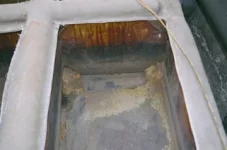SeaSwick
Active member
- Joined
- May 28, 2005
- Messages
- 70
- Status
- OWNER - I own a Hatteras Yacht
- Hatteras Model
- 41' CONVERTBLE YACHT FISH (1960 - 1963)
Let the fun begin...
Anyone have experience in opening old Hatteras fuel tanks?
I'm replacing the cockpit on the SeaSwick, a 1960 41' w/454 Crusaders, & will be opening the fuel tanks to clean & coat the inside with an ethanol proof barrier (INTERPLASTIC's CoREZYNA(r) VE8770 VINYL ESTER, rated UL1316 for "All Fuels" applications. Ethanol solvent resistant & approved for use in underground gas-station storage tanks). She's been out of the water for years & never exposed to ethanol.
Specifically, if I grind, itch, and then cut on the original top seam, will the baffles lift out with the top, or are they integral to the carcass & remain in the tank(s)? It seems BERTRAM (pardon my french) used aluminum baffles in their old 'glass tanks that are attached to the top.
If the Hatt baffles are built-into the tanks (which I'm betting on), I think I'll cut a "smaller" opening inside the edges & epoxy on a new top when the job is done.
It's been strongly recommended when coating old tanks to DOCUMENT THE WORK WITH PHOTOS, have the work inspected & reported as completed by a marine surveyer before closing up the tank. This will help in dealing with Insurance Companies (like... getting some), potential purchasers, as well as if the Hatt goes into the charter business down the road.
Thanx in advance for any $0.02
Anyone have experience in opening old Hatteras fuel tanks?
I'm replacing the cockpit on the SeaSwick, a 1960 41' w/454 Crusaders, & will be opening the fuel tanks to clean & coat the inside with an ethanol proof barrier (INTERPLASTIC's CoREZYNA(r) VE8770 VINYL ESTER, rated UL1316 for "All Fuels" applications. Ethanol solvent resistant & approved for use in underground gas-station storage tanks). She's been out of the water for years & never exposed to ethanol.
Specifically, if I grind, itch, and then cut on the original top seam, will the baffles lift out with the top, or are they integral to the carcass & remain in the tank(s)? It seems BERTRAM (pardon my french) used aluminum baffles in their old 'glass tanks that are attached to the top.
If the Hatt baffles are built-into the tanks (which I'm betting on), I think I'll cut a "smaller" opening inside the edges & epoxy on a new top when the job is done.
It's been strongly recommended when coating old tanks to DOCUMENT THE WORK WITH PHOTOS, have the work inspected & reported as completed by a marine surveyer before closing up the tank. This will help in dealing with Insurance Companies (like... getting some), potential purchasers, as well as if the Hatt goes into the charter business down the road.
Thanx in advance for any $0.02
Last edited:


